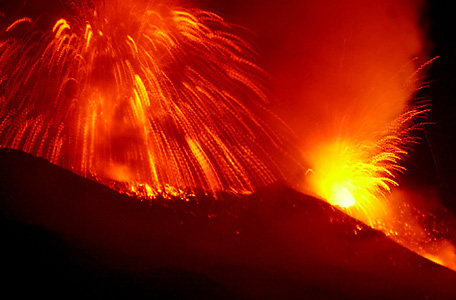Mount Etna, << EHT nuh, >> is one of the most famous volcanoes in the world. It rises 10,902 feet (3,323 meters) on the eastern coast of the island of Sicily . Part of the mountain’s base, which is about 100 miles (160 kilometers) around, extends to the Mediterranean Sea . Sicilians also know the volcano by the name Mongibello.

Mount Etna (sometimes spelled Aetna) makes a colorful picture with its snow-covered peaks, the forests growing on its slopes, and the orchards, vineyards, and orange groves around its base. Eruptions contain nutrients that contribute to the fertility of the surrounding soil. The warm, dry climate along the lower slopes grows cooler and wetter at higher elevations. The region around Etna is the most densely populated area of Sicily. Nearby are the cities of Catania and Acireale, and dozens of villages.
Mount Etna has been erupting periodically for thousands of years. Numerous major craters are found near Etna’s summit, and hundreds of smaller craters, called vents, occur along the mountain’s slopes. Writers of ancient Greece left accounts of Etna’s activity. Some of the eruptions have been extremely violent. In 1169, an earthquake accompanying an eruption killed about 15,000 people in eastern Sicily. About 20,000 people were killed in an earthquake that accompanied a 1669 eruption. Several towns were destroyed in 1950 and 1951. Violent eruptions in 1960 ripped a hole in the mountain’s east side. Eruptions, some of which have featured substantial lava flows, have occurred regularly since then. Spectacular nighttime eruptions attract numerous photographers, and eruptions that took place during the 2010’s drew wide news coverage.
